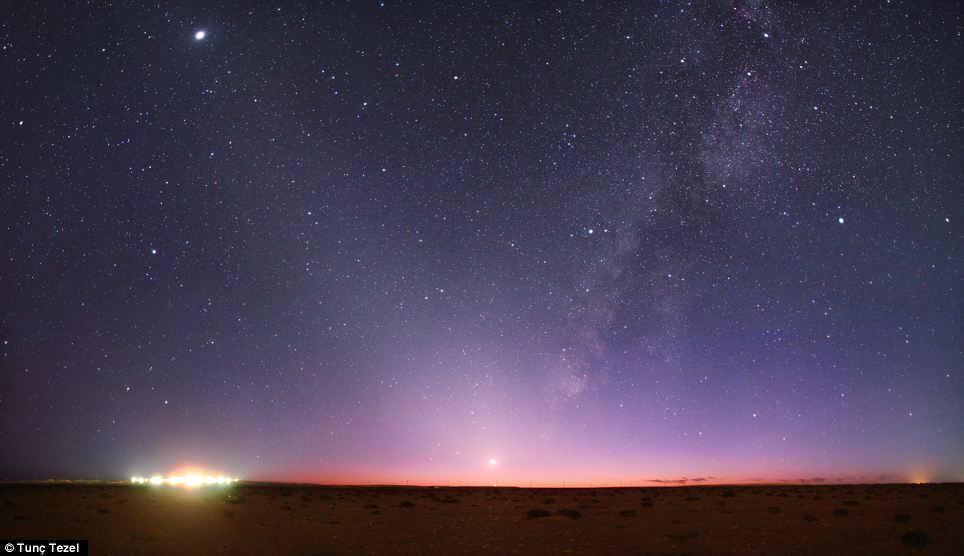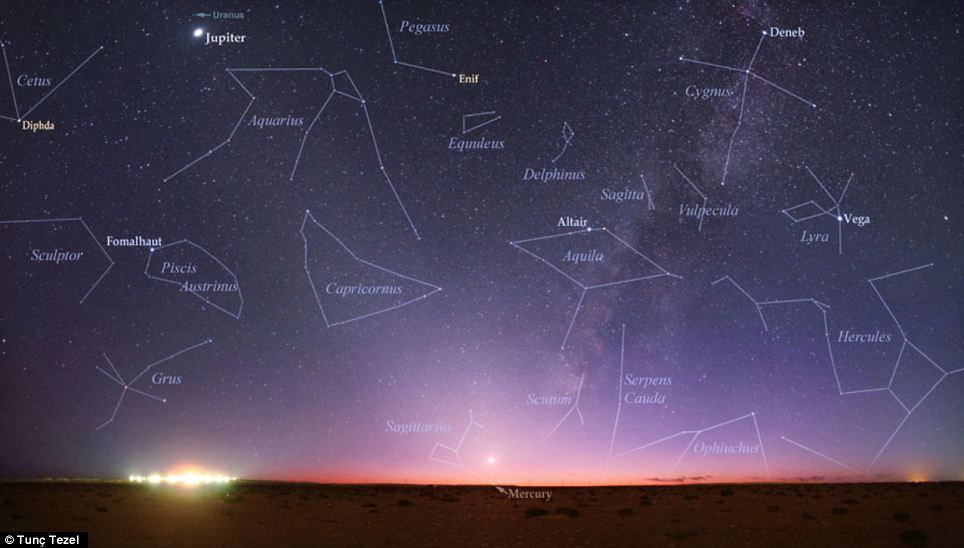Pardeep
๑۩۩๑┼●ℛŐŶ
By Jupiter! Comet dust and light from billions of stars and far-flung planets creates magnificent display in the desert night sky
If you live in a city it is easy to forget there is a stunning star-scape above your head, which is hidden by light pollution.
But out in the Libyan desert, there is little to obscure your view.
Amateur photographer and civil engineer Tunc Tezel captured the glorious night sky above Ras Lanuf camp in Libya.
 Mr Tezel's awe-inspiring photo titled 'Skylights over Libya'. He took the image on December 7 just after sunset
Mr Tezel's awe-inspiring photo titled 'Skylights over Libya'. He took the image on December 7 just after sunset
The 33-year-old from Turkey is overseeing a coastal railway construction between Sirt and Benghazi and was keen to take advantage of his isolated location.
Although a glowing sky is often cloud reflecting sun or moonlight, the flight running diagonally up to the right is created by the combined light from billions of stars that make up our local Milky Way Galaxy.
Mr Tezel took the image on December 7 an hour after sunset and managed to unveil zodiacal light as well. This is the sunlight reflected off tiny dust particles ejected by comets that orbit our Solar System.
He told the Mail Online: 'I took six pictures as a 3x2 panorama, which I later constructed with image processing software to get the final view.
'The brightest celestial object below centre is the Moon. Mercury is also visible to the lower left of the Moon and just above the horizon.
'After the sky got dark enough, the Milky Way became visible, rising to the upper right from the southwest horizon. Thanks to the clear and transparent skies that evening, Zodiacal Light was also easily seen rising from to the upper left from the southwestern horizon.'
 The night sky over the Libyan desert. Jupiter is the brightest spot in the sky
The night sky over the Libyan desert. Jupiter is the brightest spot in the sky
Mr Tezel, who has been an amateur astronomer since 1992 said his location on the northern tip of Africa was the ideal spot for capturing the night sky's beauty.
'From my southern location of Libya (30 degrees North), the Milky Way and Zodiacal Light stood nicely symmetrical,' he said.
'From farther north, Milky way would stand more upright as Zodiacal Light would be nearly invisible as it would make a very shallow angle with the horizon.'
Mr Tezel is part of an organisation called The World At Night or TWAN. The group's main aim of TWAN is to produce and present a collection of stunning photographs and time-lapse videos of the world’s landmarks against the celestial attractions.
If you live in a city it is easy to forget there is a stunning star-scape above your head, which is hidden by light pollution.
But out in the Libyan desert, there is little to obscure your view.
Amateur photographer and civil engineer Tunc Tezel captured the glorious night sky above Ras Lanuf camp in Libya.

The 33-year-old from Turkey is overseeing a coastal railway construction between Sirt and Benghazi and was keen to take advantage of his isolated location.
Although a glowing sky is often cloud reflecting sun or moonlight, the flight running diagonally up to the right is created by the combined light from billions of stars that make up our local Milky Way Galaxy.
Mr Tezel took the image on December 7 an hour after sunset and managed to unveil zodiacal light as well. This is the sunlight reflected off tiny dust particles ejected by comets that orbit our Solar System.
He told the Mail Online: 'I took six pictures as a 3x2 panorama, which I later constructed with image processing software to get the final view.
'The brightest celestial object below centre is the Moon. Mercury is also visible to the lower left of the Moon and just above the horizon.
'After the sky got dark enough, the Milky Way became visible, rising to the upper right from the southwest horizon. Thanks to the clear and transparent skies that evening, Zodiacal Light was also easily seen rising from to the upper left from the southwestern horizon.'

Mr Tezel, who has been an amateur astronomer since 1992 said his location on the northern tip of Africa was the ideal spot for capturing the night sky's beauty.
'From my southern location of Libya (30 degrees North), the Milky Way and Zodiacal Light stood nicely symmetrical,' he said.
'From farther north, Milky way would stand more upright as Zodiacal Light would be nearly invisible as it would make a very shallow angle with the horizon.'
Mr Tezel is part of an organisation called The World At Night or TWAN. The group's main aim of TWAN is to produce and present a collection of stunning photographs and time-lapse videos of the world’s landmarks against the celestial attractions.


